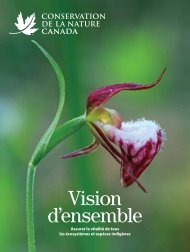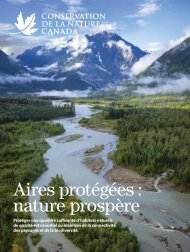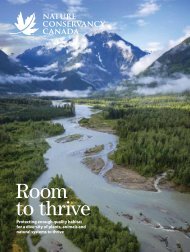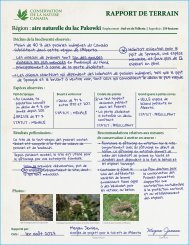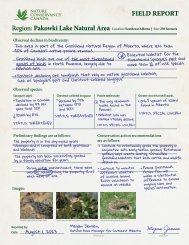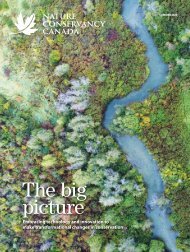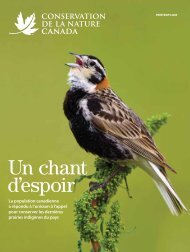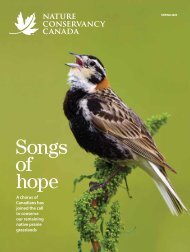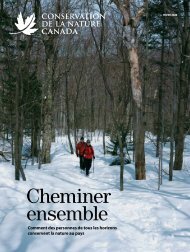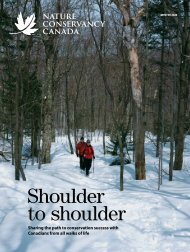NCC-AR-EN-DIgital-v3
Create successful ePaper yourself
Turn your PDF publications into a flip-book with our unique Google optimized e-Paper software.
33<br />
NOTES TO SUMM<strong>AR</strong>Y FINANCIAL STATEM<strong>EN</strong>TS<br />
MAY 31, 2019<br />
1. Summary financial statements<br />
The summary financial statements are derived from the<br />
complete audited financial statements, prepared in accordance<br />
with Canadian accounting standards for not-for-profit<br />
organizations as at May 31, 2019, and for the year then ended.<br />
The preparation of these summary financial statements<br />
requires management to determine the information that<br />
needs to be reflected in the summary financial statements so<br />
that they are consistent, in all material respects, with or<br />
represent a fair summary of the audited financial statements.<br />
These summary financial statements have been prepared<br />
by management using the following criteria:<br />
[a] whether information in the summary financial statements<br />
is in agreement with the related information in the<br />
complete audited financial statements; and<br />
[b] whether, in all material respects, the summary financial<br />
statements contain the information necessary to avoid distorting<br />
or obscuring matters disclosed in the related complete<br />
audited financial statements, including the notes thereto.<br />
Management determined that the statements of changes<br />
in net assets and cash flows do not provide additional useful<br />
information and, as such, has not included them as part of<br />
the summary financial statements.<br />
The complete audited financial statements of The Nature<br />
Conservancy of Canada [the “Conservancy”] are available<br />
upon request by contacting the Conservancy.<br />
2. Revenue recognition<br />
The Conservancy follows the deferral method of accounting<br />
for contributions. Revenue related to the sale of carbon<br />
offset credits is recognized when the Conservancy has<br />
transferred to the buyer the significant risks and rewards of<br />
the ownership of the carbon credits, the amount is fixed and<br />
determinable and collectability is reasonably assured.<br />
3. Conservation lands and agreements<br />
Purchased conservation lands and agreements are recorded<br />
at cost when title is transferred. The purchases are recorded<br />
as an expense to the extent that the purchase is internally<br />
financed. Repayments of debt related to property acquisitions<br />
are expensed when made. An amount equal to the expense<br />
related to purchases and debt repayments is added to net<br />
assets invested in conservation lands and agreements. When<br />
a loan is obtained in a subsequent year related to an internally<br />
financed purchase, an amount equal to the debt is transferred<br />
from net assets invested in conservation lands and agreements<br />
to operating surplus.<br />
Contributed conservation lands and agreements are<br />
recorded at fair market value when title is transferred. When<br />
purchased conservation lands and agreements are acquired<br />
substantially below fair market value, the difference between<br />
consideration paid and fair value is reported as contributed<br />
conservation lands and agreements. The contributions are<br />
recorded as revenue and expenses and also as an asset offset<br />
by net assets invested in conservation lands and agreements.<br />
Properties transferred to others are recorded as a<br />
reduction of conservation lands and agreements and net<br />
assets invested in conservation lands and agreements.<br />
Conservation lands and agreements, either purchased or<br />
donated, are assets held as part of the Conservancy’s<br />
collection. Conservation agreements are legal agreements<br />
entered into by the Conservancy under which a landowner<br />
voluntarily restricts or limits the type and amount of<br />
development that may take place on his or her land to<br />
conserve its natural features. Once registered on title, that<br />
agreement runs with the title and binds all future owners.<br />
4. Allocation of expenses<br />
Salaries and benefits expenses are allocated between<br />
property-related and support expenses based on the primary<br />
job responsibilities of the employee’s position. No support<br />
expenses are allocated to property-related expenses.<br />
5. Donated materials and services<br />
Donated materials and services are not recognized in the<br />
summary financial statements.<br />
6. Debt<br />
The Conservancy has provided a general security agreement<br />
over all of its assets, excluding conservation lands and<br />
agreements, with one financial institution. In addition, as at<br />
May 31, 2019, the Conservancy has one long-term debt<br />
facility of $1,634,500 that is secured by conservation lands<br />
and agreements with a carrying value of $1,673,275 and a<br />
promissory note payable of US$101,622 that is secured by<br />
conservation lands with a carrying value of $7,216,593.<br />
7. Contingencies<br />
The nature of the Conservancy’s activities is such that there is<br />
often litigation pending or in progress. Where the potential<br />
liability is likely and able to be estimated, management records<br />
its best estimate of the potential liability. With respect to claims<br />
as at May 31, 2019, it is management’s position that the<br />
Conservancy has valid defences and appropriate insurance<br />
coverage to offset the cost of unfavourable settlements, if any,<br />
which may result from such claims. In other cases, the ultimate<br />
outcome of the claims cannot be determined at this time, and<br />
as such, no accruals have been made as at May 31, 2019.<br />
ANNUAL REPORT 2018–2019



